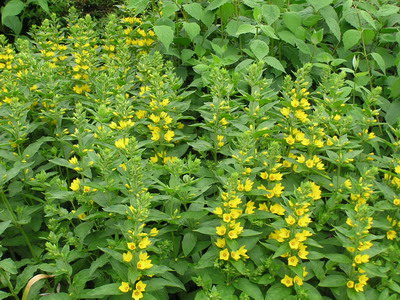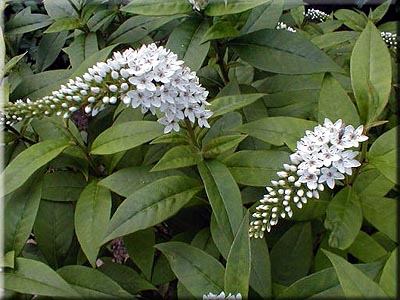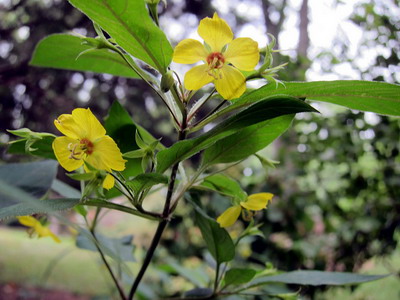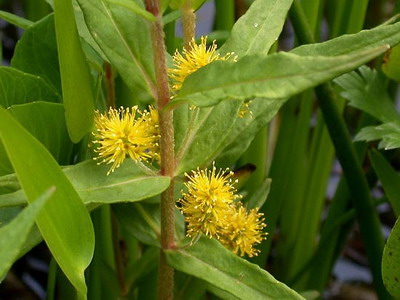 Loosestrife (Lysimachia) is a genus of perennial and biennial herbs of the primulaceae family (Primulaceae), includes about 150 species growing in temperate and subtropical zones, 70 of them in China.
Loosestrife (Lysimachia) is a genus of perennial and biennial herbs of the primulaceae family (Primulaceae), includes about 150 species growing in temperate and subtropical zones, 70 of them in China.
- Family : primroses.
- Homeland : most species – China.
- Rhizome : long branching.
- Stem : creeping or erect.
- Leaves : alternate, whorled or opposite.
- Fruit : box.
- Reproductive capacity : reproduces vegetatively and by seeds.
- Illumination : penumbra or shade.
- Watering : plentiful.
- Content temperature : cold-resistant.
- Flowering time : 30-35 days from June to September depending on the species.
Description of loosestrife flowers
Perennial, rarely biennial herbaceous plant, depending on the species, from 5 to 150 cm tall, with erect or creeping stems, entire, alternate leaves, opposite or whorled, oval, round or elongated. The loosestrife flowers are white, yellow or pink, arranged singly or in several pieces. in the axils of the leaves, in some species are collected in a corymbose or spike-paniculate inflorescence. The fruit is a box with angular seeds.
The scientific name “Lysimachia”, according to most experts, was first introduced by the ancient Roman naturalist Dioscorides. According to another version, the genus is named after Lysimachus, one of the associates of Alexander the Great. The loosestrife received the Russian name for some similarity in the shape of the leaves with willow.
It is ubiquitous in Europe and Asia, found in South America and Africa. Most species grow in China, in Russia in nature there are 11 species. The plant is unpretentious, grows well, has attractive flowers, due to which some species are used in floriculture.
Decorative species and varieties of loosestrife
As ornamental flowers loosestrife has been grown for a long time. Traditionally, ordinary, spotted and coined loosestrife are planted in gardens, but other varieties have recently been growing in popularity. Below is a description of some ornamental species and varieties.
Common loosestrife
Common loosestrife (L. vulgaris) , a perennial common in nature, often grown in flower beds. It has erect pubescent stems up to 1 m tall, opposite, ovate or oval, whorled leaves, collected in 3-4 pieces. In June-August, small bright yellow flowers bloom, collected in a complex pyramidal inflorescence. Requires a shady and semi-shady location with moist soil, tolerates waterlogging and can be grown directly in water at a depth of up to 10 cm.

Coined loosestrife
Monetary loosestrife (L. nummularia) , a creeping plant up to 5 cm high, with a stem up to 30 cm long, arranged oppositely with light green oval leaves, single axillary star-bell-shaped yellow flowers. Blossoms 15-20 days, depending on the place of growth, from June to August. A popular ground cover perennial, undemanding, fast growing in sun or shade, on horizontal ground and on steep slopes. It tolerates drought well, develops well in wet places, tolerates flooding. It can be planted near ponds and pools, decorating the shores with shoots hanging into the water. Resistant to trampling and mowing. There is a variety with golden yellow leaves “Aurea”.

Spotted loosestrife
Point loosestrife (L. punctata) is a frequently grown perennial, with vertically growing densely leafy stems up to 60-80 cm high, forming dense bushes. The leaves are opposite, oblong oval, the flowers are golden yellow with an orange middle, star-bell-shaped, grow in the axils of the leaves, 1-2 pcs. Prefers partial shade and moist soil, blooms profusely for a month or more, starting from the end of June. It grows rapidly, under favorable conditions, requires restriction, as it displaces less hardy neighbors. There are variegated varieties: “Alexander” with white and “Golden Alexander” with a yellow border around the edge of the sheet.

Loosestrife or lily-of-the-valley
Loosestrife or lily of the valley (L.clethroides) is a rather rare ornamental plant native to Northeast China, found wild in Russia in the south of Primorye. Unlike other species, it grows little, has large rhizomes, and requires a deeper nutrient soil layer. Prefers a sunny location, tolerates partial shade. It has straight, slightly branched pubescent stems up to 120 cm high, large elongated leaves with a sharp top, wedge-shaped at the base. Spectacular pure white drooping pyramidal inflorescences up to 30 cm long appear at the end of July. Blooms within 15-20 days, suitable for cutting . There is a variety of Lady Jane, 60-90 cm in height.

Purple loosestrife
Purple loosestrife (L. purpurea) is a perennial with original wine-red leaves and small lemon-yellow flowers located in the axils of the leaves in the upper part of the bush and on the tops of the stems. Forms a bush about 45 cm high, prefers a sunny location, blooms during August-September.

loosestrife
Looseflower (L.thyrsiflora) , a fast-growing plant with straight, strong stems up to 60 cm high, narrow lanceolate leaves and fluffy inflorescences of small yellow flowers with protruding stamens. The only species that blooms in late May – early June.

Below are photos of loosestrife of various types.
Growing loosestrife in the garden: seed selection, planting and watering
A place for planting most ornamental loosestrife is chosen in the shade or partial shade, purple and monetary are grown in the sun, but the latter develops better in the shade of trees.
All species prefer moist, humus-rich soil. They have a superficial root system, so 10-15 cm of the cultural layer is enough for them. They are moisture-loving, tolerate waterlogging, and ordinary, coin-shaped and racemostral species can be planted directly in water to a depth of 10 cm.
They grow well, can drown out less aggressive neighbors and require control, for example, loosestrife is preferably grown in a container. It is easiest to limit the growth of loosestrife with its superficial root system.
Growing loosestrife does not cause any particular difficulties; only abundant watering and periodic addition of compost are required. Plants are frost-resistant, hibernate without shelter. In autumn, upright varieties are cut at the root and mulched with humus or compost, creeping ones, for example, monate, are not cut, but mulched.
In one place can grow up to 10 years. Propagated by division of bushes, root offspring, segments of rhizomes, or seeds. Transplants and divisions are preferably carried out in early spring before the leaves bloom, or in early autumn.
Seeds can be sown indoors for seedlings, for which in February-March they are placed superficially in a mixture of peat and sand, seedlings are kept at a moderate temperature, planted in the ground in June. Seedlings bloom for 2-3 years. For better seed germination, some experts recommend post-sowing stratification for 1-2 months, for which plants are planted in the ground in autumn before winter.







